‘Devalay’ is an abode of God, meaning, the actual existence of God. ‘By going to a Devalay our wishes are accepted by God and we experience mental peace’ – with this faith the devotees visit a Devalay. It is said that God yearns for bhav (Spiritual emotion). It does not matter which way a staunch devotee with bhav has darshan (View of the Deity), he still experiences God’s grace; however, an ordinary devotee does not have as much bhav and hence, it is imperative that he has darshan in a spiritually correct manner. Our shastras provide us with knowledge, through which we can incorporate simple acts while visiting the devalay in order to have maximum benefit of the darshan.
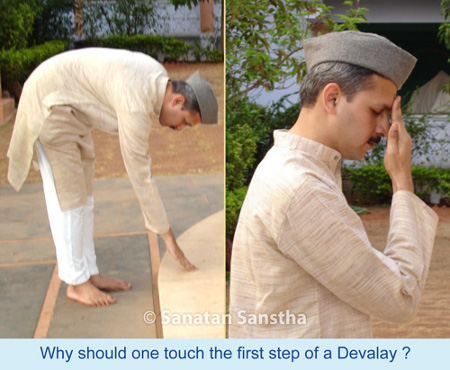
1. Doing Namaskar to each step of the Devalay
If there are steps at the entrance of the Devalay, Namaskar should be done to each step while climbing up. Namaskar to a step can be done by touching a step with the fingers of the right hand and placing the hand at the Adnya-chakra . This amounts to Namaskar to the Chaitanya (Divine consciousness) of the Chaitanya-bhumi (Chaitanya endowed land) of the Devalay. It activates the Chaitanya in the land and provides benefit to the individual. It helps in destroying the Raja-Tama particles present on the body of the individual. Also, the steps are a link that takes the individual from duality to God, meaning, non-duality.
2. Picture based on subtle-
knowledge of a devotee paying
obeisance by touching the steps of
a temple with his right hand and then
touching the Adnya-chakra with the same hand
Click on the below Subtle Drawing / Picture for a larger view !
A. Positive vibrations in the picture based on subtle-knowledge : 2%’ – H.H. Dr. Athavale (Sanatan’s source of inspiration).
B. Proportion of vibrations : Divine Principle – 1.25%, Chaitanya – 1%, Shakti (Divine Energy) – 2%
3. Importance of touching each step of a Devalay
A. Having darshan of the Deity of the temple sooner due to dissolution of ego by touching the steps of the temple, and awakening of bhav of complete surrender : When a person touches the steps of a temple his ego dissolves. When the ego dissolves, ‘I’-ness gets destroyed and enlightenment takes place – Which means that he has darshan of God in the true sense. This does not happen because of the person; rather, God only bestows His darshan. Nothing remains after camphor burns; similarly, nothing remains in a person after dissolution of ego, and darshan of the Deity takes place sooner. Bhav of complete surrender also gets awakened in the person.
B. The person becomes introverted and moves from the world of Maya (Great Illusion) to Brahman (God).
C. Elimination of the black energy covering around the body upon activation of the Surya-nadi (Sun channel): When the person bends to touch the steps of the temple, his Surya-nadi gets activated and the black covering around his body is eliminated.
D. Being conscious about God-realisation : A person becomes humble upon touching the steps of the temple and is conscious that, ‘In the same way, he has to attain God-realisation by climbing one step at a time’. By touching the steps of the temple, a person becomes humble, modest and devoted, and starts becoming one with God.
E. With every step, the person destroys his shadaripus (Six foes) and inculcates qualities for God-realisation, and finally, he has darshan of God, that is, Final Liberation.
H. Obtaining the Earth Principle : Touching the steps of a temple amounts to having darshan of Mother Earth and performing Her ritualistic worship before having darshan of the Deity of the temple. It is because of this that the person obtains the Earth Principle. – Ms. Priyanka Lotlikar, Sanatan Sanstha (Nij Vaishakh Krushna 14, Kaliyug Varsh 5112, 11th June 2010).
4. A devotee paying obeisance by touching
the steps of a temple with his right hand and
then touching the Adnya chakra with the same hand.
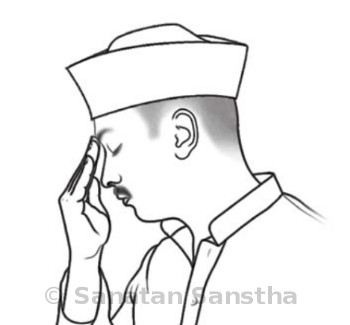
Click on the below Subtle Drawing / Picture for a larger view !
A. Positive vibrations in the picture based on subtle-knowledge : 2%’ – H.H. Dr. Athavale
B. Proportion of vibrations : Chaitanya – 2.25%, Shakti – 1%
5. Subtle benefits of touching the
steps of a temple with the right hand and then
touching the Adnya chakra with the same hand
A. When the devotee touches his Adnya-chakra with his right hand after touching the steps of the temple, the Principles absorbed through the Panchatattva (Five Cosmic Principles) emitted by the steps of the temple enter his body through the Adnya-chakra.
B. Due to the vibrations absorbed through the Adnya-chakra, the black energy covering on the devotee’s body, mind and intellect created by the mantriks (Subtle sorcerers) is eliminated. Consequently, the devotee is able to easily absorb the vibrations in the form of blessings emitted by the Deity.
C. Unnecessary thoughts arising in the devotee’s mind and the intellect which instigates these thoughts are associated with the Adnya-chakra. By touching the steps of the temple with the hand and then touching the Adnya-chakra with it, there is a reduction in the proportion of thoughts.
– Ms. Priyanka Lotlikar, Sanatan Sanstha (Nij Vaishakh Krushna 14, Kaliyug Varsh 5112, 11th June 2010)
6. When spiritual science says do not
do Namaskar with one hand, is it correct
to do Namaskar to the step with one hand ?
Namaskar to a step while climbing the steps of a Devalay is a sattvik (see glossary) action that should be performed within a short time while simultaneously balancing oneself. Climbing the steps is a Raja-predominant movement, resulting in activation of the Raja component in the body of the individual. Touching the steps with one hand, that is, with the fingers of the right hand leads to transmission of sattvik and calm waves of the Chaitanya-bhumi into the body through the fingers. This, in a way, amounts to keeping under control the Raja component in the body of the individual through the medium of Surya-nadi, meaning, the momentary fulfilment of the duty of the Surya-nadi. Through this process, the individual is taught to make use of the Raja component for enhanciing the sattvikta. Hence, the relevant actions become appropriate at the respective level.’
– A Scholar (Through the medium of Mrs. Anjali Gadgil, 17th January 2005)

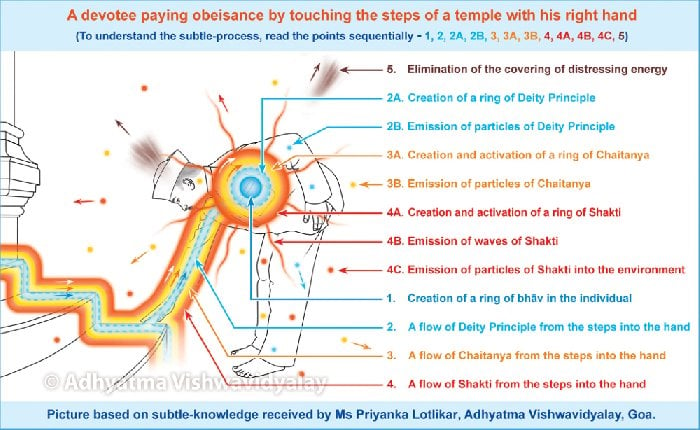
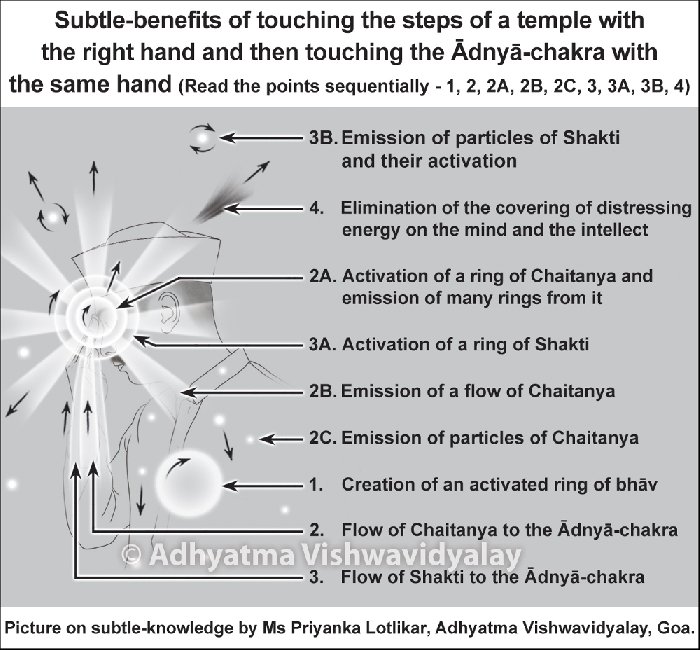
 Importance of donating after having darshan (viewing) in a Devalay (Temple)
Importance of donating after having darshan (viewing) in a Devalay (Temple) Actions to be performed while leaving the Devalay (Temple) and their underlying science
Actions to be performed while leaving the Devalay (Temple) and their underlying science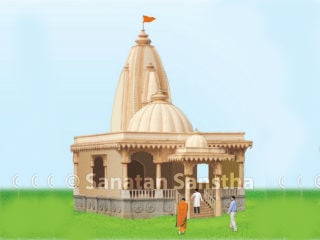 The seven layers in the arrangement of a Devalay (Temple)
The seven layers in the arrangement of a Devalay (Temple)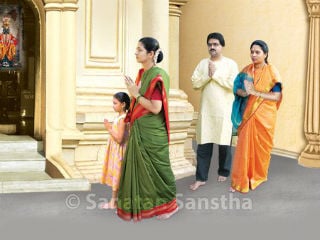 How many pradakshinas (circumambulations) should be performed around a Deity ?
How many pradakshinas (circumambulations) should be performed around a Deity ?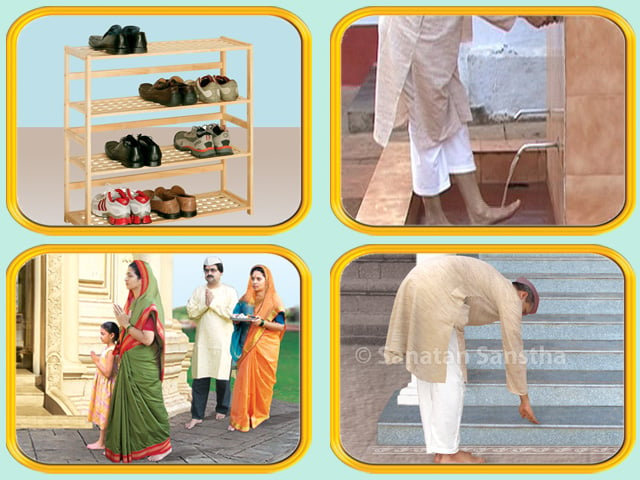 Actions to be performed before entering a Devalay (Temple) and the underlying science
Actions to be performed before entering a Devalay (Temple) and the underlying science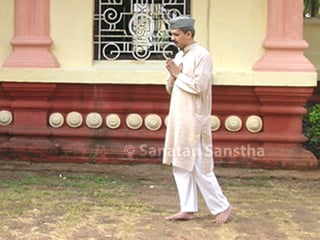 Method of going from the premises towards the sabhamandap of the Devalay (Temple)
Method of going from the premises towards the sabhamandap of the Devalay (Temple)